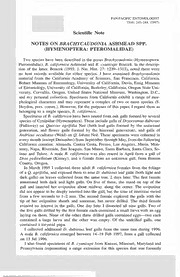
Notes on Brachycaudonia Ashmead spp. (Hymenoptera: Pteromalidae) PDF
Preview Notes on Brachycaudonia Ashmead spp. (Hymenoptera: Pteromalidae)
PAN-PACIFIC ENTOMOLOGIST 73(4): 243-244, (1997) Scientific Note NOTES ON BRACHYCAUDONIA ASHMEAD SPP. (HYMENOPTERA: PTEROMALIDAE) Two species have been described in the genus Brachycaudonia (Hymenoptera: Pteromalidae), B. californica Ashmead and B. cyaniceps Boucek. In the descrip¬ tion of the latter, Boucek (1993. J. Nat. Hist. 27: 1239-1313), noted there were no host records available for either species. I have examined Brachycaudonia material from the California Academy of Sciences, San Francisco, California, Bohart Museum of Entomology, University of California, Davis, Essig Museum of Entomology, University of California, Berkeley, California, Oregon State Uni¬ versity, Corvallis, Oregon, United States National Museum, Washington, D.C., and my personal collection. Specimens from California exhibit a range of mor¬ phological characters and may represent a complex of two or more species (S. Heydon, pers. comm.). However, for the purposes of this paper, I regard them as belonging to a single species, B. californica. Specimens of B. californica have been reared from oak galls formed by several species of Cynipidae (Hymenoptera). These include galls of Dryocosmus dubiosus (Fullaway) on Quercus agrifolia Nee (both leaf galls formed by the unisexual generation, and flower galls formed by the bisexual generation), and galls of Andricus occultatus (Weld) on Q. lobata Nee. These specimens were collected in every month (except December) from September through May, from the following California counties: Alameda, Contra Costa, Fresno, Los Angeles, Marin, Mon¬ terey, Napa, Riverside, San Joaquin, San Mateo, Santa Barbara, Santa Clara, So¬ lano and Tulare. A male B. californica was also reared in April from a gall of Dros pedicellatum (Kinsey), and a female from an unknown gall, from Benton County, Oregon. In March 1995 I collected three adult B. californica females from the foliage of a Q. agrifolia, and exposed them to nine D. dubiosus leaf galls (both light and dark galls) on leaves collected from the same tree, 2 days later. The first female antennated both dark and light galls. On five of these, she stood on top of the gall and inserted her ovipositor about midway along the center. The ovipositor did not appear to be deeply inserted into the gall, but the time of insertion varied from a few seconds to 1—2 min. The second female explored the galls with the tip of her ovipositor sheath and antennae, but never drilled. The third female evinced no interest in the galls. One day later I dissected all nine galls. Two of the five galls drilled by the first female each contained a small larva with an egg laying on them. None of the other three drilled galls contained eggs—two each contained a large larva and the other was empty. Of the undrilled galls, one contained a torymid pupa. I collected additional D. dubiosus leaf galls from the same tree during 1996. A male B. californica emerged between 14-18 Feb 1997, from a gall collected on 13 Jul 1996. I also found specimens of B. cyaniceps from Kansas, Missouri, Maryland and Pennsylvania (representing a range extension for this species that was formerly 244 THE PAN-PACIFIC ENTOMOLOGIST Vol. 73(4) reported only from New York and Ontario) but rearing data are not available. The specimen from Maryland is a male, 1.4 mm long, and largely resembles the female, except for the following characteristics: antennae only slightly clavate; propodeal plicae absent; relative length of marginal vein 13, stigmal vein 10, postmarginal vein 13; gaster slightly longer than mesosoma; entire dorsum of gaster non-metallic light brown; head and mesosoma concolorous, maculation of wing lighter. This specimen was taken from a malaise trap, so the true colors may be different from those reported here. Two Brachycandonia specimens from Minnesota and Michigan resemble B. cyaniceps, but are without rearing data. Thus, in the western United States Brachycaudonia is associated with cynipid galls from Quercus species, probably as an ectoparasitoid. Interestingly, one spec¬ imen each of B. californica and B. cyaniceps was collected from a peach tree or orchard. However, it is unknown if these species are primary or secondary par- asitoids, or if they attack gall-makers or inquilines. I have also reared Torymus fnllawayi (Huber) (Hymenoptera: Torymidae), a IBrasema sp. (Hymenoptera: Eu- pelmidae), two Aprostocetus spp. (Hymenoptera: Eulophidae), and a Synergus sp. (Hymenoptera: Cynipidae) from D. dubiosus leaf galls on Q. agrifolia. Of special interest is the rearing of B. californica from galls formed by both the unisexual and bisexual generations of D. dubiosus. Askew (1961. Trans. Soc. Brit. Entomol. 14: 237-268) noted that the same parasitoid species seldom at¬ tacked alternating generations of the same cynipid host, as the gall’s structure, placement on tree and the season of growth were the most important factors in determining its parasitoid complement, and these varied between alternating gen¬ erations. However, Doutt (1959. Ann. Entomol. Soc. Am. 52: 69—74), noted that D. dubiosus flower galls are found from February-May in California, and I have noted leaf galls in March and April. Presumably, this seasonal overlap in gall occurrence facilitates the transfer of B. californica between the alternating gen¬ erations of the cynipid. Acknowledgment.—I thank Eric Grissell of the Systematic Entomology Labo¬ ratory, % United States National Museum, Jim Lebonte of Oregon State Univer¬ sity and Steve Heydon of the University of California, Davis for their assistance in providing specimens, and Ken Hagen of the University of California, Berkeley for reviewing the manuscript. Robert L. Zuparko, Center for Biological Control, 201 Wellman Hall, Univer¬ sity of California, Berkeley, California 94720. Received 31 Oct 1996; Accepted 5 Feb 1997.
